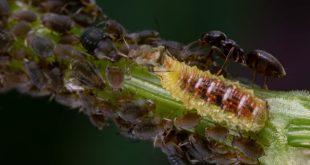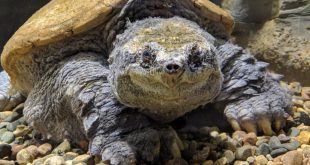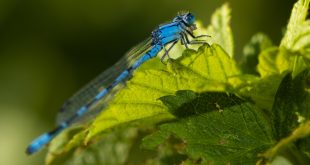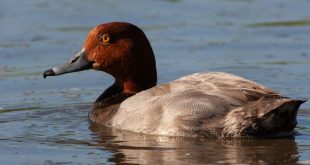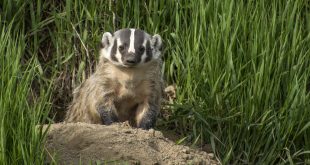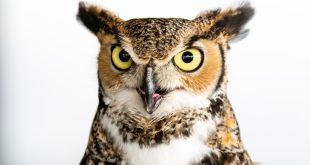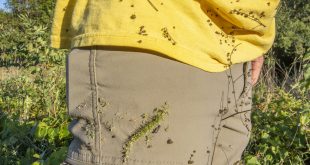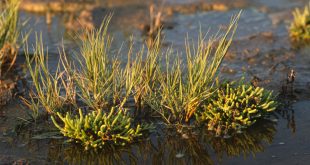Ants raise aphids to harvest their sugar-rich waste secretions known as honeydew. By Tyler Moore, Bellevue University With more than 15,000 described species of ants, as noted in “Bolton’s Catalogue of the Ants of the World,” these organisms are among the world’s most successful and represent a total estimated biomass of 12 megatons. They have also long been the subject of amateur naturalists and scientists, with perhaps no behavior more intriguing than the “farming” of aphids. Aphids are commonly known …
Read More »Meet Big Snap Daddy
Meet the star of Schramm Education Center. By Renae Blum Meet the star of Schramm Education Center’s aquarium, Big Snap Daddy. Weighing 98 pounds, he is considered the world’s largest common snapping turtle. He is also estimated to be over 90 years old. In the wild, common snapping turtles live an average of 30 years and grow to be about 35 pounds. Learn more about this remarkable creature from Schramm Park superintendent and aquarium director Tony Korth. How did Big …
Read More »October At-Risk Species – Spooky Important Species
Halloween’s “scary” creatures of the night are not as spooky as they appear. By Olivia DaRugna, Wildlife Diversity Biologist With Halloween right around the corner, let’s highlight a few critters that get a bad rap in scary movies and TV specials. Bats Bats are often portrayed as spooky, flying creatures of the night in Halloween movies, yet globally, they provide important ecosystem services, such as pest consumption, plant pollination and seed dispersal. They use flight and echolocation to catch and …
Read More »Dragonflies and Damselflies
How to tell the difference between a dragonfly and damselfly. By Monica Macoubrie, Wildlife Education Specialist The words “dragons” and “damsels” might remind you of the fairytales you heard or read a child — of daring swordfights, far-off places, dragons to conquer and of course, the damsel in distress. Well, it’s 2023, and women can fight their own way out of perilous situations. This story will discuss different dragons and damsels – the insects known as odonates. Belonging to the …
Read More »October Wildlife Viewing – Waterfowl Migration
October marks the beginning of the waterfowl migration to their wintering grounds. By Olivia DaRugna, Watchable Wildlife Biologist October marks the start of migration for many waterfowl species as they make their way back to wintering grounds. At the start of migration, it’s a trickle of just a few individuals here and there, but as the month progresses, that trickle turns into a stream of ducks landing on water bodies throughout the state, typically swelling into large aggregations as winter …
Read More »Musty Mustelids – Stinky Animals
Mustelids are a diverse group of animals that possess distinctive characteristics. By Monica Macoubrie, Wildlife Education Specialist When we think of stinky animals, our brains routinely conjure up images of a skunk spraying. However, you might be surprised to learn that skunks only make up a fraction of the “stinkers” in the animal kingdom. In Nebraska, we have an entire group of musty smellers known as mustelids, or Mustelidae. Mustelids are a group of animals that have long, tube-shaped bodies, …
Read More »Animal Vision
The size, shape and abilities of eyes vary in the animal kingdom. By Monica Macoubrie, Wildlife Education Specialist “Eyes on the side hide, eyes on the front hunt.” The size, ability and position of the eyes of animals can vary widely depending on the species, environment and whether the animal is predator or prey. Some animals can move their eyes independently; some can see in ultraviolet light; and others can’t really see much at all. Throughout this article, we will …
Read More »September Wildlife Viewing – Fall Birding
By Olivia DaRugna Summer has come and gone, and with it disappears the familiar songs and breeding activity of birds. For many birds, the end of summer means fueling their bodies with caterpillars, bugs and berries for the journey south to wintering grounds. Several species have just started the gorging phase in September, while others have already taken flight, such as hummingbirds and curlews. Birders, too, need to prepare for the challenges that come with fall birding. In the fall, …
Read More »The Things That Stick to Us – Seeds
A celebration of the ways seeds transport themselves around the world and onto our pants and pets. Story and photos by Chris Helzer We’ve all been there. You’re in the middle of a perfectly pleasant walk through a woodland, wetland or prairie and you glance down to find your pant legs covered with sticky seeds. “Well, dadgum,” you exclaim, “would you look at that incredible seed dispersal adaptation!” “Golly,” you continue, “those little hooked spines sure are effective at catching …
Read More »Just a Little Salty – Nebraska’s Saline Wetlands
By Monica Macoubrie, Wildlife Education Specialist One would never guess looking at Nebraska’s prairies: A hundred million years ago, it was once a vast sea inhabited by shark-like marine reptiles, and when the sea finally retreated, it left behind remnants of salt, and quite a bit of it. The saline wetlands that surround our capital city, Lincoln, is still as salty as today’s oceans. Nebraska is far from any coastline, more than 1,000 miles to be specific, yet it is …
Read More » Nebraskaland Magazine
Nebraskaland Magazine
